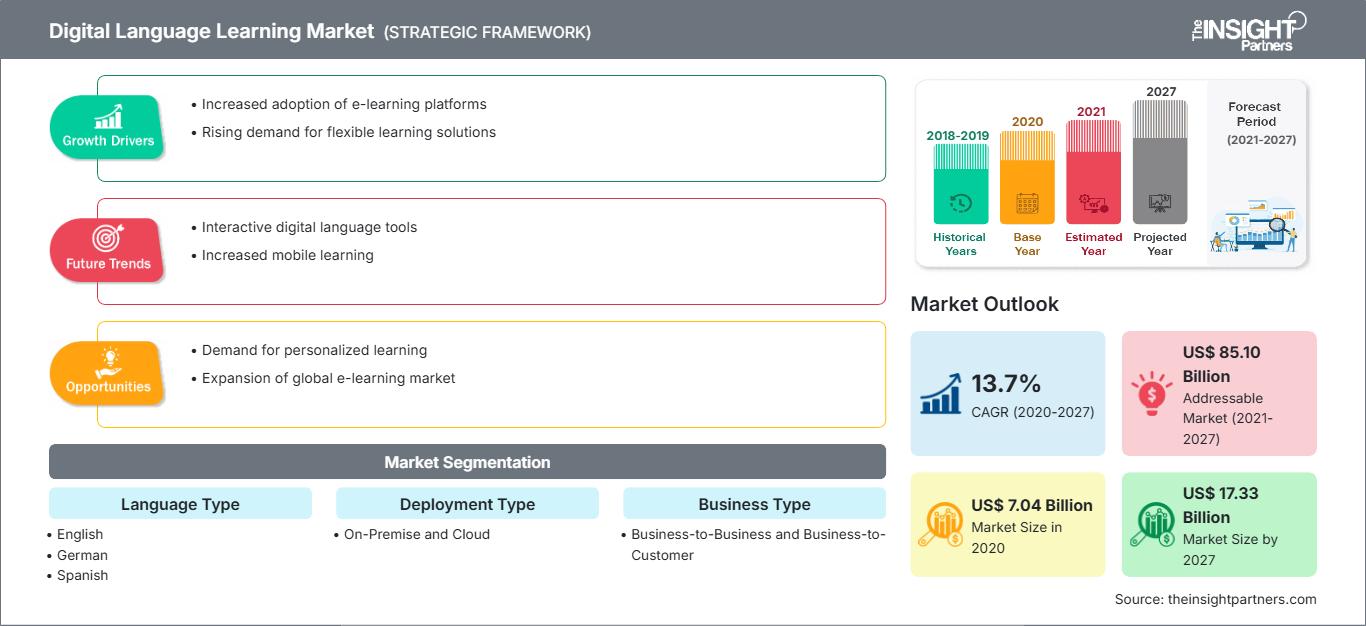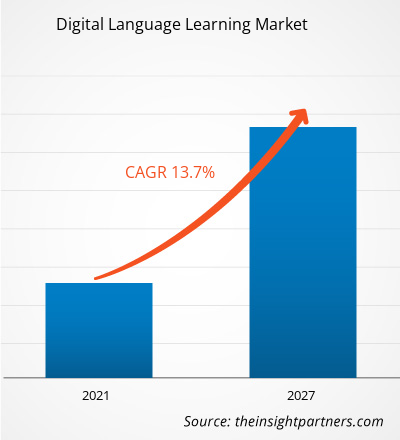디지털 언어 학습 시장은 2020년 70억 3,820만 달러에서 2027년 1억 7,333만 달러로 성장할 것으로 예상되며, 2020년부터 2027년까지 연평균 성장률 13.7%로 성장할 것으로 예상됩니다.
다양한 정부의 영어 학습 프로그램 시행 계획이 시장 성장에 기여하고 있습니다. 디지털로 향상된 성과를 제공하기 위해 정부와 민간 기관이 추진하는 다양한 계획에 힘입어 세계 교육 분야는 기하급수적으로 변화하고 있습니다. 중국, 호주, 브라질, UAE 등 여러 국가의 정부는 지난 몇 년간 디지털 교육 계획을 시행하여 이들 국가의 영어 교육 시스템 발전에 기여했습니다. 예를 들어, 10년 전 호주 정부가 시작한 디지털 교육 혁명(DER)은 여러 학교와 대학이 디지털 교육을 활용할 수 있도록 했습니다. 마찬가지로 중국 정부도 영어 학습에 중점을 둔 디지털 교육을 촉진하기 위한 여러 정책을 시행했으며, 이는 중국 학생들에게 디지털 학습 솔루션을 제공하는 기업의 수를 증가시켰습니다. 51Talk는 중국에서 가장 유명한 디지털 영어 학습 기관 중 하나이며, 17Zuoye는 중국 학생, 교사, 학부모를 위한 또 다른 디지털 플랫폼으로, 연습 문제와 숙제 형태의 온라인 과제를 제공하여 최종 사용자의 역량 향상을 지원합니다. 현재 인도는 디지털 교육 시장을 위한 실질적인 시장 공간을 조성하기 위해 노력하고 있습니다. 인도 정부는 교육 분야의 디지털화 기술을 대중화하기 위해 다양한 사업을 추진하고 있습니다. SWAYAM은 인도 정부가 추진하는 가장 대표적인 디지털 학습 플랫폼이자 사업으로, 학생들이 고등 교육의 모든 과목을 다루는 온라인 강좌를 선택할 수 있도록 지원합니다. 해외 대학들도 SWAYAM 플랫폼을 통해 각자의 강좌와 시험을 제공할 수 있도록 허용되어 학생들이 해외 대학의 시험을 선택하고 학습할 수 있도록 지원합니다. 이를 통해 학생들의 영어 학습, 말하기, 쓰기 능력이 향상됩니다. 국가 디지털 도서관은 인도 정부가 단일 창구를 통해 학습 자료를 가상으로 제공한다는 비전을 가지고 추진하는 또 다른 사업입니다. 이 사업은 점차 주목을 받고 있으며, 향후 인도의 디지털 영어 학습 시장 성장을 촉진하여 글로벌 디지털 언어 학습 시장의 성장에 기여할 것으로 예상됩니다.
이 보고서의 일부, 국가 수준 분석, Excel 데이터 팩을 포함하여 모든 보고서에 대한 사용자 정의를 무료로 받을 수 있을 뿐만 아니라 스타트업 및 대학을 위한 훌륭한 제안 및 할인을 이용할 수 있습니다
디지털 언어 학습 시장: 전략적 통찰력

- 이 보고서의 주요 주요 시장 동향을 확인하세요.이 무료 샘플에는 시장 동향부터 추정 및 예측에 이르기까지 데이터 분석이 포함됩니다.
최근 팬데믹 발발은 지난 몇 달 동안 전 세계적으로 기존 교육 분야에 상당한 긍정적 변화를 가져왔습니다. 더욱이, 기존 교육 기관과 교실 기반 학습 기술의 붕괴는 강력하고 효율적인 온라인 및 디지털 학습 솔루션 도입의 급증을 가져왔으며, 이는 향후 몇 년 동안 팬데믹 이후에도 시장 성장을 지속적으로 견인할 것으로 예상됩니다. 예를 들어, 유네스코는 기술 기업 및 국제전기통신연합(ITU)의 주요 관계자들과 협력하여 신흥 경제국에서 물리적 인프라에 대한 상당한 투자 없이도 더 많은 사람들에게 빠른 학습 역량을 제공하기 위해 디지털 기술 도입의 경제적 중요성을 강조했습니다. 한편, 케임브리지 대학교에서 실시한 별도 설문 조사에서는 1,200명이 넘는 응답자가 향후 몇 년 동안 디지털 학습 기술을 계속 사용할 의향이 증가할 것이라고 답했습니다. 따라서 최근의 코로나19 확산은 디지털 학습 기술 도입을 급증시켰고, 이는 지난 몇 달 동안 시장 성장에 긍정적인 영향을 미쳤습니다.
시장 분석 - 디지털 언어 학습 시장은 첨단 및 간소화된 기술을 활용하여 학생들을 디지털 교육으로 유치하고 있습니다.
미국과 영국과 같은 선진국에서는 학교, 대학교 및 기타 교육기관의 학생들이 디지털 교육 시스템에 대해 잘 알고 있기 때문에 디지털 교육 시스템이 큰 인기를 얻고 있습니다. 그러나 아시아 태평양(APAC) 및 남미(SAM) 국가의 학생들은 기술 기반 학습에 대한 인식이 부족합니다. 여러 학교, 대학교 및 교육 기관에서 수업에 디지털 기술을 도입하고 있습니다. 디지털 교육 플랫폼 개발자들이 강력한 솔루션을 제공하기 위해 끊임없이 기술을 업그레이드함에 따라, 아시아 태평양 지역의 도입 기업들도 기술 인프라를 지속적으로 업그레이드하고 있습니다. 혁신적인 클라우드 기반 교육 앱, 웹사이트 및 기타 서비스는 디지털 언어 학습 솔루션을 포함한 디지털 교육 시장을 크게 확대할 것으로 예상됩니다.
언어 유형 기반 인사이트
언어 유형을 기준으로 디지털 언어 학습 시장은 영어, 중국어, 스페인어, 독일어 등으로 세분화됩니다. 2019년에는 영어 부문이 가장 큰 시장 점유율을 기록했습니다.디지털 언어 학습 시장 지역별 통찰력
The Insight Partners의 분석가들은 예측 기간 동안 디지털 언어 학습 시장에 영향을 미치는 지역별 동향과 요인들을 면밀히 분석했습니다. 이 섹션에서는 북미, 유럽, 아시아 태평양, 중동 및 아프리카, 그리고 중남미 지역의 디지털 언어 학습 시장 부문 및 지역별 현황도 살펴봅니다.
디지털 언어 학습 시장 보고서 범위
| 보고서 속성 | 세부 |
|---|---|
| 시장 규모 2020 | US$ 7.04 Billion |
| 시장규모별 2027 | US$ 17.33 Billion |
| 글로벌 CAGR (2020 - 2027) | 13.7% |
| 이전 데이터 | 2018-2019 |
| 예측 기간 | 2021-2027 |
| 다루는 세그먼트 |
By 언어 유형
|
| 포함된 지역 및 국가 | 북미
|
| 시장 선도 기업 및 주요 회사 프로필 |
|
디지털 언어 학습 시장 참여자 밀도: 비즈니스 역학에 미치는 영향 이해
디지털 언어 학습 시장은 소비자 선호도 변화, 기술 발전, 그리고 제품 이점에 대한 인식 제고 등의 요인으로 인한 최종 사용자 수요 증가에 힘입어 빠르게 성장하고 있습니다. 수요가 증가함에 따라 기업들은 제품 및 서비스를 확장하고, 소비자 니즈를 충족하기 위한 혁신을 추진하며, 새로운 트렌드를 적극 활용하고 있으며, 이는 시장 성장을 더욱 가속화하고 있습니다.

- 을 얻으세요 디지털 언어 학습 시장 주요 주요 플레이어 개요
디지털 언어 학습 시장에서 활동하는 업체들은 주로 고급스럽고 효율적인 제품 개발에 집중하고 있습니다.
- 2019년, Fluenz는 2020년 봄 스페인 바르셀로나에서 스페인어 럭셔리 몰입 프로그램을 확장한다고 발표했습니다. 사용자는 6일 동안 언어 학습을 위해 프로그램에 참여할 수 있습니다.
- 2018년, Preply, Inc.는 2019년 초 바르셀로나에 새 사무실을 열 계획을 발표했습니다. 이 확장은 7월에 400만 달러의 투자 유치의 결과였습니다. 회사는 독일, 영국, 미국 및 라틴 아메리카 시장에서의 입지를 더욱 확대할 계획입니다.
디지털 언어 학습 시장은 다음과 같이 세분화되었습니다.
글로벌 디지털 언어 학습 시장 - 언어 유형별
- 영어
- 독일어
- 스페인어
- 중국어
- 기타
글로벌 디지털 언어 학습 시장 - 배포 유형별
- 온프레미스
- 클라우드
글로벌 디지털 언어 학습 시장 - 비즈니스 유형별
- 기업 간 거래
- 기업 대 고객 거래
글로벌 디지털 언어 학습 시장 - 최종 사용자
- 학술
- 비학문
글로벌 디지털 언어 학습 시장 – 지역별
- 북미
- 미국
- 캐나다
- 멕시코
- 유럽
- 프랑스
- 독일
- 이탈리아
- 러시아
- 영국
- 나머지 국가 유럽
- 아시아 태평양(APAC)
- 일본
- 중국
- 호주
- 인도
- 대한민국
- APAC 나머지 지역
- 중동 및 아프리카(MEA)
- 사우디아라비아
- UAE
- 남부 아프리카
- MEA의 나머지 지역
- 남아메리카(SAM)
- 브라질
- 아르헨티나
- 나머지 SAM의
디지털 언어 학습 시장 - 회사 프로필
- Babbel
- Busuu, Ltd.
- Fluenz
- Lingoda GmbH
- Living Language (Penguin Random House, LLC)
- Pearson PLC
- Preply, Inc.
- Rosetta Stone, Inc.
- Verbling, Inc.
- Yabla, Inc.
- 과거 분석(2년), 기준 연도, CAGR을 포함한 예측(7년)
- PEST 및 SWOT 분석
- 시장 규모 가치/거래량 - 글로벌, 지역, 국가
- 산업 및 경쟁 환경
- Excel 데이터세트
최근 보고서
관련 보고서
사용 후기
구매 이유
- 정보에 기반한 의사 결정
- 시장 역학 이해
- 경쟁 분석
- 고객 인사이트
- 시장 예측
- 위험 완화
- 전략 기획
- 투자 타당성 분석
- 신흥 시장 파악
- 마케팅 전략 강화
- 운영 효율성 향상
- 규제 동향에 발맞춰 대응




















 무료 샘플 받기 - 디지털 언어 학습 시장
무료 샘플 받기 - 디지털 언어 학습 시장